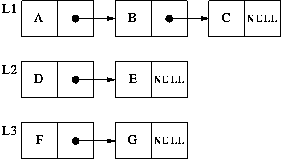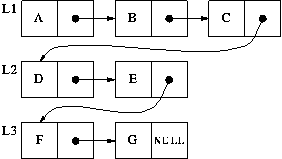

1. Our Specification Of Lists - General Considerations
There is no unique way to specify an abstract data type. Last lecture
we saw two `standard' specifications for lists, we will now develop
our own. Specifications differ in two main ways:
- what are the primitive parts out of which lists are
composed.
- what are the primitive operations on lists.

The choice of primitive operations is important, because it directly
determines:
- Functionality:
- Users must write their functions using only the primitives that
are provided. Some functions may be impossible to write with a
given set of primitives. We must be sure that all the functions
that might be needed by the user can be written using the
primitives we provide.
For example, the primitive operations on arrays provided by
Pascal do not permit the user to change the size of an array
dynamically. This was a design decision made when Pascal was
specified.
- Efficiency:
- How efficient will the user's code be?
- User Convenience:
- How much effort it will be for the user to write the functions
he really needs? This is important because, in practice, the
cost to develop software, and the number of tricky bugs that are
in it, are closely linked with the amount of effort required to
write the software.
For example, in the classical List specification, there is
just one `current' node in any given list. This is
actually very inconvenient: in many applications, it is
necessary to access two elements of the same list
simultaneously. It is not impossible to accomplish this within
the classical specification, but doing so involves extra work
and tricks which obscure the function being performed.
- Maintainability:
- A program is easily maintainable if it can easily be understood
and changed. To ensure that the code that implements an abstract
data type is very easily maintained, there should be as small a
set of primitive operations as possible, and each primitive
operation should be very simple.
We will view a list as a collection of elements that are organized in
a linear fashion. The primitive operations that we will provide is
determined by the following general considerations:
- A list is a special kind of collection. In the most general
notion of `collection' the elements in a collection are not
organized in any particular way. Lists are collections having an
additional property: the order on elements. There are many very
powerful operations that can be defined on collections generally
- we'll see several shortly - and we would like to be able to
apply these to lists too.
- We would like all our primitive operations to be very efficient.
More precisely, we want them to be constant time and
constant space operations - which means they will use
the same time and space to process lists of any size. There will
be obvious exceptions - operations which, by definition, must
access each element in the list one-by-one - but all other
operations should require constant time and space.
- There are some very commonly-used operations that we would like
to ensure are done as efficiently as possible. For example, one
of the most common operations on a list or collection is
determining its size (length). Another pair of common operations
are joining together two lists and the inverse: splitting one
list into two (the front and back). In the classical
specification, these operations require going through the list
element by element - therefore, they are not constant time
operations - they are quick for short lists but very slow for
very long lists. We will make them primitive operations and make
them constant time.
- We will generalize the classical idea of a current node:
we will allow the user to access any number of list elements
simultaneously. To do this, we will define an abstract type
called window, which gives access to an element in a
list; the user can have as many windows as he likes. We will
have to define operations on windows, that permit them to be
created, moved around, inspected, and so on.
- We will not have any operations that result in the same element
being a member of two different lists. This may sound strange,
but it is a situation that can very easily arise, even with
ordinary primitives like TAIL or our JOIN operation. To see
this, consider the following example.

Suppose we have three lists,

and we join L1 and L2 together using the JOIN operation. This
operation captures the intuitive meaning of `join', resulting in list:

What is the relation between this list and the ones we started with?
One possibility, which seems very natural, is that L1 and L2 have
literally been glued together, so that L1 is the result of
the operation (L2 has been glued onto the end of it), and L2 is
the last 2 elements of L1:

Why is this a problem? Well, because some operations on L2 will affect
L1, and, likewise, some operations on L1 will affect L2. For example,
if we now JOIN L1 and L3, L2 will be affected:

As you can imagine, if this happens, things get very confusing!

There are at least four ways to avoid this confusion:
- return a copy. L1 and L2 are unaffected by JOIN. This
solution tends to be memory hungry.
- keep L1 and L2 completely separate: put all the elements that
would normally be shared into just one of them. In this
approach, JOIN(L1,L2) transfers the elements from L2 into L1: L2
ends up with nothing in it.
- change the `type' of L2: it is now a `sublist' instead of a
`list'. Then restrict some operations to operate only on lists,
not on sublists (typically sublists can be inspected but not
changed). This gives the advantages of sharing (efficient memory
use) without the problems.
- L1 and L2 become exactly the same list - all subsequent
operations on one of them have identical effects on both. They
become two names for the very same list: we say that they become
`unified'.

(2), (3), and (4) are equally acceptable. We will use (2) for lists,
and (3) for trees later in the course. We will discuss (4) in more
detail next lecture.
This decision is not a mere implementation detail. It is a crucial
consideration in formulating our specification. It affects how we
define the behaviour of our operations - we have just described 5
different ways the JOIN operation might behave. In order to write an
application that uses JOIN, the applications programmer must know
which of these five behaviours he will get.




